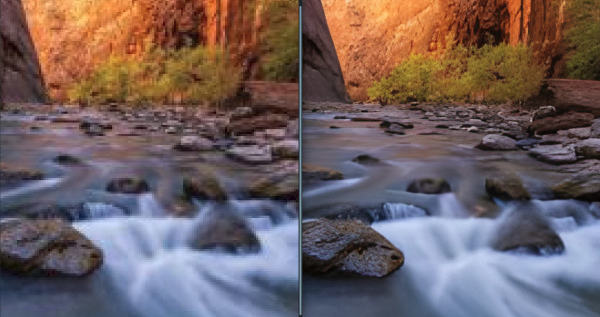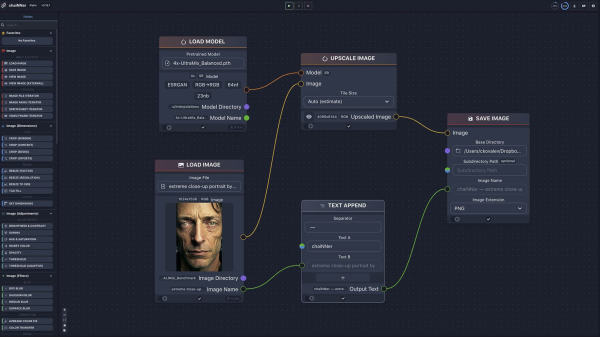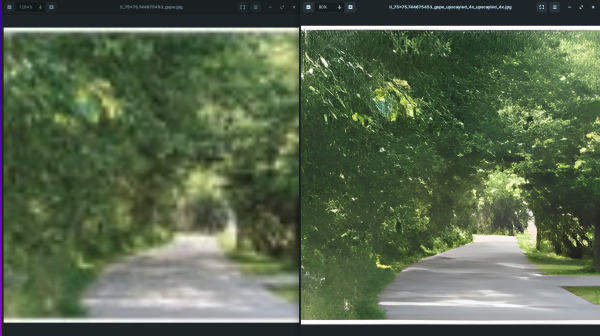[17:13 Mon,23.January 2023 by Thomas Richter] |
Until recently, the idea of subsequently increasing the resolution of an image and thus making more image details visible would have been dismissed as impossible. Thanks to DeepLearning AI algorithms, this has been possible for several years - first there was research work on so-called www.slashcam.de/news/single/mehr-bildschaerfe-durch-kuenstliche-Intelligenz---Su-13281. html (super resolution) (aka upscaling) algorithms, then soon software with the help of which users could also upscale images (and videos) themselves.  Picture scaled up by Upscayl Visual artist Andrei Kovalev has now published an interesting and very detailed test of such AI upscaling tools, in which he compares several paid and free image upscaling programs, here with the specific purpose of increasing the resolution of www.slashcam .de/artikel/News/KI-macht-s-posglich--Fake-Filmstills-von-Fritz-Langs-Star-Wars--Jodorowskys-Tron-und-mehr--Fake-Filmstills-per-.html (Midjourney AI) created images for printing. The popular paid standalone desktop app Gigapixel AI Kovalev provides very nice interactive image comparisons of the various upscaling AIs and also explains the use and operation of the different programs and lists their strengths and weaknesses. In the test, five very different images generated mid-journey are used as comparison images (a 3D rendering, a geometric abstraction, a line drawing, a detailed brush drawing, a painted image and a portrait photo. The latter comes from classic photos, which are probably the most commonly used image types for upscaling For comparison, the image resolution is quadrupled by the respective software from specifically 1,024 x 1,536 to 4,096 x 6,144 pixels resolution.  Upscaling comparison images For each program, it offers a comparison of the respective upscaling of all five sample images with the result of Gigapixel AI. In addition to the default model, for several programs it also shows examples of special upscaling algorithms or options that were developed for special purposes such as upscaling faces or line drawings . In addition, he also states the computing time (which, however, is more meaningful in comparing the desktop computing times with each other than absolutely meaningful, since he uses a rather old 2013 Mac Pro with 3.5 GHz 6-Core Intel Xeon E5 CPU including AMD FirePro D500 3GB VRAM graphics card). If you want to try out the tools yourself, you should first check whether your own system is supported based on the respective hardware requirements.  chaiNNer What is Super Resolution?While it used to be assumed that when the resolution was increased, no details could be added that are not contained in the original image (because the information for them is missing), a paradigm shift has been taking place for several years thanks to Super Resolution Technology, because now one can More detail is added to the image than was originally available in digital form. But how is that possible? Super resolution methods do not use the old and rather primitive interpolation between known pixels for the "more pixels" and thus more image information, but instead invent coherent details. This is made possible by deep learning technology, since these AI algorithms, thanks to training with millions of images, are very good at recognizing all possible types of objects in an image and adding them in a meaningful way. When upscaling, neural networks take advantage of the typical patterns of natural objects - i.e. structures in the low-resolution images are meaningfully reconstructed when upscaling.  Picture scaled up by Upscayl For example, if a corresponding Super Resolution AI has seen millions of faces from different angles and in various lighting situations, it can then add the appropriate details it has learned to each face in an image that has only been roughly resolved. This also applies to plants, cars, animals or any other object. However, one should keep in mind that the resulting upscaled images contain only very likely additional details and not the "true" details from the original recording situation of the image. deutsche Version dieser Seite: Großer Vergleichstest: Upscaling per KI - welches Tool ist am besten (und kostenlos)? |





